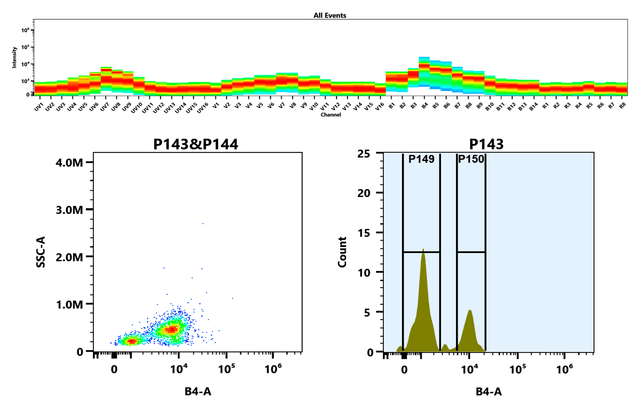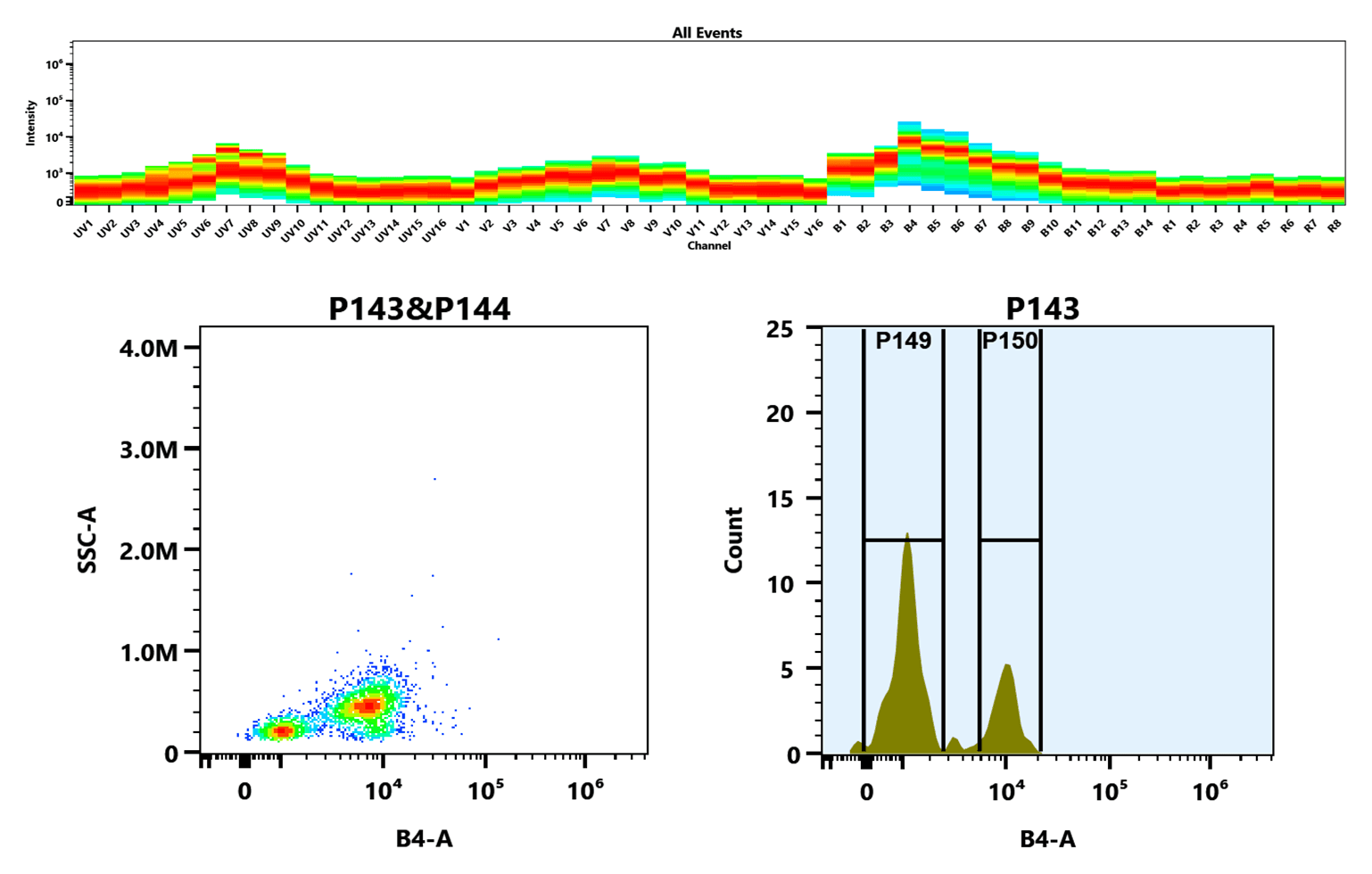mFluor™ Blue 583 SE
| Price | |
| Catalog Number | |
| Unit Size | |
| Quantity |
| Telephone | 1-800-990-8053 |
| Fax | 1-800-609-2943 |
| sales@aatbio.com | |
| International | See distributors |
| Bulk request | Inquire |
| Custom size | Inquire |
| Shipping | Standard overnight for United States, inquire for international |
| Molecular weight | 770.84 |
| Solvent | DMSO |
| Correction Factor (260 nm) | 1.17 |
| Correction Factor (280 nm) | 0.35 |
| Extinction coefficient (cm -1 M -1) | 450001 |
| Excitation (nm) | 498 |
| Emission (nm) | 585 |
| H-phrase | H303, H313, H333 |
| Hazard symbol | XN |
| Intended use | Research Use Only (RUO) |
| R-phrase | R20, R21, R22 |
| Storage | Freeze (< -15 °C); Minimize light exposure |
| Overview |
Molecular weight 770.84 | Correction Factor (260 nm) 1.17 | Correction Factor (280 nm) 0.35 | Extinction coefficient (cm -1 M -1) 450001 | Excitation (nm) 498 | Emission (nm) 585 |
Example protocol
PREPARATION OF STOCK SOLUTIONS
Unless otherwise noted, all unused stock solutions should be divided into single-use aliquots and stored at -20 °C after preparation. Avoid repeated freeze-thaw cycles
Mix 100 µL of a reaction buffer (e.g., 1 M sodium carbonate solution or 1 M phosphate buffer with pH ~9.0) with 900 µL of the target protein solution (e.g. antibody, protein concentration >2 mg/mL if possible) to give 1 mL protein labeling stock solution.
Note: The pH of the protein solution (Solution A) should be 8.5 ± 0.5. If the pH of the protein solution is lower than 8.0, adjust the pH to the range of 8.0-9.0 using 1 M sodium bicarbonate solution or 1 M pH 9.0 phosphate buffer.
Note: The protein should be dissolved in 1X phosphate buffered saline (PBS), pH 7.2-7.4. If the protein is dissolved in Tris or glycine buffer, it must be dialyzed against 1X PBS, pH 7.2-7.4, to remove free amines or ammonium salts (such as ammonium sulfate and ammonium acetate) that are widely used for protein precipitation.
Note: Impure antibodies or antibodies stabilized with bovine serum albumin (BSA) or gelatin will not be labeled well. The presence of sodium azide or thimerosal might also interfere with the conjugation reaction. Sodium azide or thimerosal can be removed by dialysis or spin column for optimal labeling results.
Note: The conjugation efficiency is significantly reduced if the protein concentration is less than 2 mg/mL. For optimal labeling efficiency the final protein concentration range of 2-10 mg/mL is recommended.
Add anhydrous DMSO into the vial of mFluor™ Blue 583 SE to make a 10 mM stock solution. Mix well by pipetting or vortex.
Note: Prepare the dye stock solution (Solution B) before starting the conjugation. Use promptly. Extended storage of the dye stock solution may reduce the dye activity. Solution B can be stored in the freezer for two weeks when kept from light and moisture. Avoid freeze-thaw cycles.
SAMPLE EXPERIMENTAL PROTOCOL
This labeling protocol is specifically optimized for the conjugation of goat anti-mouse IgG with mFluor™ Blue 583 SE. Further optimization may be necessary for other proteins.
Note: Each protein requires a distinct dye/protein ratio, which also depends on the properties of dyes. Over-labeling of a protein could detrimentally affect its binding affinity, while the protein conjugates of low dye/protein ratio give reduced sensitivity.
Use a 10:1 molar ratio of Solution B (dye)/Solution A (protein) as the starting point. Add 5 µL of the dye stock solution (Solution B, assuming the dye stock solution is 10 mM) into the vial of the protein solution (95 µL of Solution A) with effective shaking. The concentration of the protein is ~0.05 mM assuming the protein concentration is 10 mg/mL and the molecular weight of the protein is ~200KD.
Note: We recommend using a 10:1 molar ratio of Solution B (dye)/Solution A (protein). If it is too low or too high, determine the optimal dye/protein ratio at 5:1, 15:1, and 20:1 respectively.
Continue to rotate or shake the reaction mixture at room temperature for 30-60 minutes.
The following protocol is an example of dye-protein conjugate purification by using a Sephadex G-25 column.
Prepare Sephadex G-25 column according to the manufacture instruction.
Load the reaction mixture (From "Run conjugation reaction") to the top of the Sephadex G-25 column.
Add PBS (pH 7.2-7.4) as soon as the sample runs just below the top resin surface.
Add more PBS (pH 7.2-7.4) to the desired sample to complete the column purification. Combine the fractions that contain the desired dye-protein conjugate.
Note: For immediate use, the dye-protein conjugate needs to be diluted with staining buffer, and aliquoted for multiple uses.
Note: For longer-term storage, the dye-protein conjugate solution needs to be concentrated or freeze-dried.
The Degree of Substitution (DOS) is the most important factor for characterizing dye-labeled protein. Proteins of lower DOS usually have weaker fluorescence intensity, but proteins of higher DOS (e.g., DOS > 6) tend to have reduced fluorescence too. The optimal DOS for most antibodies is recommended between 2 and 10, depending on the properties of dye and protein. For effective labeling, the degree of substitution should be controlled to have 6-8 moles of mFluor™ Blue 583 SE to one mole of antibody. The following steps are used to determine the DOS of mFluor™ Blue 583 SE labeled proteins.
To measure the absorption spectrum of a dye-protein conjugate, it is recommended to keep the sample concentration in the range of 1-10 µM depending on the extinction coefficient of the dye.
For most spectrophotometers, the sample (from the column fractions) needs to be diluted with de-ionized water so that the O.D. values are in the range of 0.1 to 0.9. The O.D. (absorbance) at 280 nm is the maximum absorption of protein, while 583 nm is the maximum absorption of mFluor™ Blue 583 SE. To obtain accurate DOS, ensure the conjugate is free of the non-conjugated dye.
You can calculate DOS using our tool by following this link: https://www.aatbio.com/tools/degree-of-labeling-calculator
Calculators
Common stock solution preparation
| 0.1 mg | 0.5 mg | 1 mg | 5 mg | 10 mg | |
| 1 mM | 129.729 µL | 648.643 µL | 1.297 mL | 6.486 mL | 12.973 mL |
| 5 mM | 25.946 µL | 129.729 µL | 259.457 µL | 1.297 mL | 2.595 mL |
| 10 mM | 12.973 µL | 64.864 µL | 129.729 µL | 648.643 µL | 1.297 mL |
Molarity calculator
| Mass (Calculate) | Molecular weight | Volume (Calculate) | Concentration (Calculate) | Moles | ||||
| / | = | x | = |
Spectrum

Spectral properties
| Correction Factor (260 nm) | 1.17 |
| Correction Factor (280 nm) | 0.35 |
| Extinction coefficient (cm -1 M -1) | 450001 |
| Excitation (nm) | 498 |
| Emission (nm) | 585 |
Product Family
| Name | Excitation (nm) | Emission (nm) | Extinction coefficient (cm -1 M -1) | Correction Factor (260 nm) | Correction Factor (280 nm) |
| mFluor™ Blue 570 SE | 553 | 565 | 1200001 | 0.228 | 0.179 |
| mFluor™ Blue 630 SE | 470 | 632 | 490001 | 0.197 | 0.275 |
| mFluor™ Blue 660 SE | 481 | 663 | 260001 | 0.338 | 0.32 |
| mFluor™ Blue 580 SE | 485 | 580 | 400001 | 0.363 | 0.247 |
| mFluor™ Blue 590 SE | 569 | 589 | 810001 | 0.671 | 0.406 |
| mFluor™ Blue 620 SE | 589 | 616 | 980001 | 0.683 | 0.849 |
| mFluor™ Blue 585 SE | 491 | 578 | 450001 | - | - |
| mFluor™ Blue 615 SE | 510 | 615 | 400001 | - | - |
Images
References
Authors: Zöller, Katrin and Karlegger, Anna and Truszkowska, Martyna and Stengel, Daniel and Bernkop-Schnürch, Andreas
Journal: Journal of colloid and interface science (2024): 174-188
Authors: Raadsen, M and Langerak, T and Du Toit, J and Kruip, M J H A and Aynekulu Mersha, D and De Maat, M P M and Vermin, B and Van den Akker, J P C and Schmitz, K S and Bakhtiari, K and Meijers, J C M and van Gorp, E C M and Short, K R and Haagmans, B and de Vries, R D and Gommers, D A M P J and Endeman, H and Goeijenbier, M and ,
Journal: Journal of critical care (2024): 154463
Authors: Schofield, Craig J and Tirouvanziam, Rabindra and Garratt, Luke W
Journal: Cytometry. Part A : the journal of the International Society for Analytical Cytology (2024)
Authors: Giacalone, Vincent D and Giraldo, Diego Moncada and Silva, George L and Hosten, Justin and Peng, Limin and Guglani, Lokesh and Tirouvanziam, Rabindra
Journal: Frontiers in immunology (2023): 1194253
Authors: Liu, Xiao-Yu and Wang, Yong-Hong and Wang, Jing and Quan, Ji-Kun and Li, Xu-Dong and Guan, Kun-Ping
Journal: Hematology (Amsterdam, Netherlands) (2023): 1-9
Authors: Castaño, Nicolas and Chua, Kaiser and Kaushik, Abhinav and Kim, Sungu and Cordts, Seth C and Nafarzadegan, Ceena D and Hofmann, Grady H and Seastedt, Hana and Schuetz, Jackson P and Dunham, Diane and Parsons, Ella S and Tsai, Mindy and Cao, Shu and Desai, Manisha and Sindher, Sayantani B and Chinthrajah, R Sharon and Galli, Stephen J and Nadeau, Kari C and Tang, Sindy K Y
Journal: Allergy (2023)
Authors: Lantz, Larry and Holmes, Kevin and Douagi, Iyadh
Journal: Current protocols (2023): e795
Authors: Tlatelpa-Romero, Beatriz and Contreras-Cruz, David Atahualpa and Guerrero-Luna, Gabriel and Hernández-Linares, María Guadalupe and Ruiz-Salgado, Sinuhé and Mendoza-Milla, Criselda and Romero, Yair and de-la-Rosa Paredes, René and Oyarzábal, Luis F and Mendoza-Sámano, Diego Alejandro and Galván-León, Jiovani Alfredo and Vázquez-de-Lara, Luis G
Journal: Chemistry and physics of lipids (2023): 105349
Authors: Bharti, Niharika and Rai, Mohit Kumar and Singh, Snigdha and Agarwal, Vikas and Prasad, Narayan and Pandey, Rakesh and Agrawal, Vinita
Journal: International urology and nephrology (2023)
Authors: Cardenas, Hannah L and Evanoff, Nicholas G and Fandl, Hannah K and Berry, Auburn R and Wegerson, Kendra N and Ostrander, Emily I and Greiner, Jared J and Dufresne, Sheena R and Kotlyar, Michael and Dengel, Donald R and DeSouza, Christopher A and Garcia, Vinicius P
Journal: Journal of applied physiology (Bethesda, Md. : 1985) (2023): 271-278


